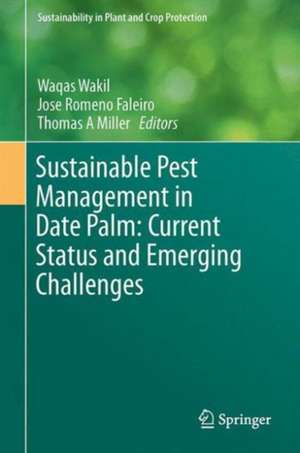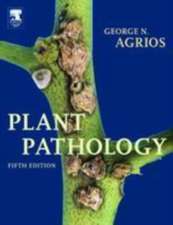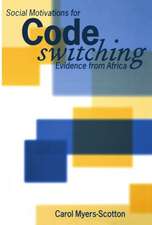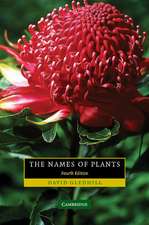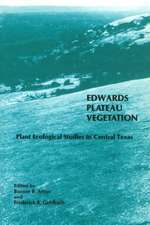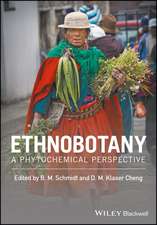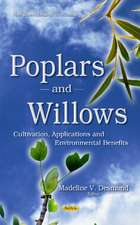Sustainable Pest Management in Date Palm: Current Status and Emerging Challenges: Sustainability in Plant and Crop Protection
Editat de Waqas Wakil, Jose Romeno Faleiro, Thomas A. Milleren Limba Engleză Hardback – 5 ian 2016
A recent report on the arthropod fauna of date palm, enlists 112 species of insects and mites associated with date palm worldwide including 22 species attacking stored dates. Enhanced monoculture of date palm in several date palm growing countries coupled with climate change, unrestrained use of chemical insecticides and extensive international trade is likely to impact the pest complex and the related natural enemies in the date agro-ecosystems. In view of the importance of date palm as an emerging crop of the future and the need to develop and deploy ecologically sound and socially acceptable IPM techniques, this book aims to comprehensively address issues related to the biology and sustainable management of major insect and mite pests of date palm by assessing the current IPM strategies available, besides addressing emerging challenges and future research priorities. The issues pertaining to the role of semiochemicals in date palm IPM involving new strategies revolving around “attract andkill” and “push-pull” technologies, phytoplasmas and their insect vectors with implications for date palm, innovative methods for managing storage pests of dates and knowledge gaps in devicing sustainable strategies for the management of red palm weevil, Rhynchophorus ferrugineus (Olivier) are also addressed
| Toate formatele și edițiile | Preț | Express |
|---|---|---|
| Paperback (1) | 795.55 lei 38-44 zile | |
| Springer International Publishing – 30 mar 2018 | 795.55 lei 38-44 zile | |
| Hardback (1) | 818.76 lei 38-44 zile | |
| Springer International Publishing – 5 ian 2016 | 818.76 lei 38-44 zile |
Din seria Sustainability in Plant and Crop Protection
- 18%
 Preț: 1244.08 lei
Preț: 1244.08 lei - 24%
 Preț: 794.96 lei
Preț: 794.96 lei - 18%
 Preț: 1126.59 lei
Preț: 1126.59 lei - 15%
 Preț: 648.24 lei
Preț: 648.24 lei - 24%
 Preț: 781.64 lei
Preț: 781.64 lei - 18%
 Preț: 1107.56 lei
Preț: 1107.56 lei - 24%
 Preț: 810.45 lei
Preț: 810.45 lei - 24%
 Preț: 1053.51 lei
Preț: 1053.51 lei - 24%
 Preț: 792.90 lei
Preț: 792.90 lei - 20%
 Preț: 558.51 lei
Preț: 558.51 lei - 23%
 Preț: 579.82 lei
Preț: 579.82 lei - 24%
 Preț: 835.82 lei
Preț: 835.82 lei - 18%
 Preț: 944.67 lei
Preț: 944.67 lei - 18%
 Preț: 1380.98 lei
Preț: 1380.98 lei - 18%
 Preț: 951.91 lei
Preț: 951.91 lei - 18%
 Preț: 1229.28 lei
Preț: 1229.28 lei
Preț: 818.76 lei
Preț vechi: 1077.31 lei
-24% Nou
Puncte Express: 1228
Preț estimativ în valută:
156.71€ • 161.50$ • 132.30£
156.71€ • 161.50$ • 132.30£
Carte tipărită la comandă
Livrare economică 25 februarie-03 martie
Preluare comenzi: 021 569.72.76
Specificații
ISBN-13: 9783319243955
ISBN-10: 3319243950
Pagini: 429
Ilustrații: XX, 429 p. 115 illus., 102 illus. in color.
Dimensiuni: 155 x 235 x 30 mm
Greutate: 1 kg
Ediția:1st ed. 2015
Editura: Springer International Publishing
Colecția Springer
Seria Sustainability in Plant and Crop Protection
Locul publicării:Cham, Switzerland
ISBN-10: 3319243950
Pagini: 429
Ilustrații: XX, 429 p. 115 illus., 102 illus. in color.
Dimensiuni: 155 x 235 x 30 mm
Greutate: 1 kg
Ediția:1st ed. 2015
Editura: Springer International Publishing
Colecția Springer
Seria Sustainability in Plant and Crop Protection
Locul publicării:Cham, Switzerland
Public țintă
ResearchCuprins
1. Date Palm Production and Pest Management Challenges.- 2. Biology and Management of Red Palm Weevil.- 3. Bridging the Knowledge Gaps for Development of Basic Components of Red Palm Weevil IPM.- 4. Longhorn Stem Borer and Frond Borer of Date Palm.- 5. Dynastid Beetle Pests.- 6. Carob Moth, Lesser Date Moth and Raisin Moth.- 7. Major Hemipteran Pests.- 8. Sap Beetles.- 9. Pests of Stored Dates.- 10. Phytoplasmas and their Insect Vectors: Implications for Date Palm.- 11. The Role of Semiochemicals in Date Pest Management.- 12. Mite Pests of Date Palms.- 13. Post-harvest Processing of Dates: Drying, Disinfestation and Storage
Textul de pe ultima copertă
Date palm, Phoenix dactylifera L. (Arecales: Arecaceae), is an important palm species cultivated since pre-historic times in the arid regions of the world and traditionally associated with the life and culture of the people in the Middle-East and North Africa which are the pre-dominant date palm growing regions worldwide. The crop is currently cultivated in nearly 30 countries in the Asian, African, American and Australasian continents. The Food and Agriculture Organization of the UN estimates that there are over 100 million date palms world wide with an annual production of over 7.5 million tonnes
Date palm is attacked by a wide range of insect pests mainly from the orders Coleoptera, Lepidoptera and Hemiptera besides phytophagous mites, several of which cause substantial loss in yield and even mortality of palms. During the last two decades there has been a significant increase in date palm cultivation worldwide especially in the Middle-East and North Africa where the area has increased over 50%, mostly in vast stretches of monoculture plantations offering a conducive macro and micro ha
bitat for existing and emerging insect pests of date palm. Global warming together with rapid large scale movement of palm species for farming and ornamental gardening has compounded the threat of insect pests to date palm. Indiscriminate use of insecticides to control these pests as the first line of defense is of major concern in the date growing countries due to the inherent disadvantages of insecticidal residues in dates (affecting exports), development of resistance to insecticides in the target species and resurgence of minor pest to major insect pest associated with chemical controlThe book provides an overview on the biology (life cycle, damage, losses, geographical distribution, host range) and management (monitoring, action thresholds, biological control, chemical control, mechanical control, use of semiochemicals and biopesticides) of major arthropod pests of date palm from the orders Coleoptera (red palm weevil, long horn beetle, rhinoceros beetle, frond borer, sap beetles), Hemiptera (dubas bug, issid bug, scale insects, mealy bug) and Lepidoptera (lesser date moth, carob moth, raisin moth), and mites. The issues pertaining to the role of semiochemicals in date pest management and innovative methods for managing storage pests of dates are also addressed. The book on date palm IPM will serve as a document for farmers, students, researchers and administrators involved in the date palm industry
Date palm is attacked by a wide range of insect pests mainly from the orders Coleoptera, Lepidoptera and Hemiptera besides phytophagous mites, several of which cause substantial loss in yield and even mortality of palms. During the last two decades there has been a significant increase in date palm cultivation worldwide especially in the Middle-East and North Africa where the area has increased over 50%, mostly in vast stretches of monoculture plantations offering a conducive macro and micro ha
bitat for existing and emerging insect pests of date palm. Global warming together with rapid large scale movement of palm species for farming and ornamental gardening has compounded the threat of insect pests to date palm. Indiscriminate use of insecticides to control these pests as the first line of defense is of major concern in the date growing countries due to the inherent disadvantages of insecticidal residues in dates (affecting exports), development of resistance to insecticides in the target species and resurgence of minor pest to major insect pest associated with chemical controlThe book provides an overview on the biology (life cycle, damage, losses, geographical distribution, host range) and management (monitoring, action thresholds, biological control, chemical control, mechanical control, use of semiochemicals and biopesticides) of major arthropod pests of date palm from the orders Coleoptera (red palm weevil, long horn beetle, rhinoceros beetle, frond borer, sap beetles), Hemiptera (dubas bug, issid bug, scale insects, mealy bug) and Lepidoptera (lesser date moth, carob moth, raisin moth), and mites. The issues pertaining to the role of semiochemicals in date pest management and innovative methods for managing storage pests of dates are also addressed. The book on date palm IPM will serve as a document for farmers, students, researchers and administrators involved in the date palm industry
Caracteristici
Albeit individual reviews, book chapters etc. on the pest complex and management of date palm are available, but there is no book on the biology and management of insect pests of date palm 118 illustrations on the biology and management of insect and mite pests of date palm including the high quality color plates Renowned experts in the field of date palm IPM worldwide contributed chapters in the book The book will be the standard peer-reviewed reference for the economically important insect and mite pests associated with date palm Includes supplementary material: sn.pub/extras
